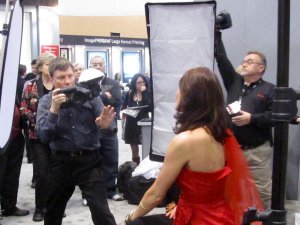Online Magazine
Recent Posts
- Safeguard your Cellphone Photos
- Black & White to Color – Instantly
- Wearing Many Hats
- Video Roundup
- Rescuing Your Blurry Pictures
- Showing Their Age
- What is Your Angle?
- Panorama Photos
- Humorous Photos
- Close Ups
- Fisheye Pictures
- Photo Antiquities
- Printing Big
- Appreciating Scale
- Celebrity Sightings
Tags
More Places to Go
- Free "How-To" Books “How To” books for popular cameras 0
- Vist Us on Facebook keep in touch with us on Facebook 2
Archives
- July 2023 (1)
- March 2023 (2)
- February 2023 (1)
- December 2022 (1)
- October 2022 (1)
- September 2022 (8)
- August 2022 (9)
- July 2022 (1)
- June 2022 (1)
- June 2021 (1)
- May 2021 (1)
- March 2021 (5)
- February 2021 (4)
- January 2021 (2)
- April 2019 (1)
- March 2019 (1)
- February 2019 (1)
- October 2018 (2)
- April 2018 (1)
- March 2018 (4)
- February 2018 (1)
- November 2017 (1)
- August 2017 (1)
- June 2017 (1)
- April 2017 (1)
- March 2017 (5)
- February 2017 (2)
- January 2017 (1)
- October 2016 (1)
- September 2016 (1)
- August 2016 (1)
- July 2016 (1)
- May 2016 (1)
- April 2016 (1)
- March 2016 (2)
- February 2016 (1)
- January 2016 (2)
- December 2015 (1)
- November 2015 (1)
- October 2015 (3)
- April 2015 (1)
- March 2015 (5)
- February 2015 (1)
- January 2015 (4)
- December 2014 (2)
- November 2014 (5)
- October 2014 (2)
- September 2014 (1)
- August 2014 (2)
- July 2014 (1)
- May 2014 (1)
- April 2014 (5)
- March 2014 (5)
- December 2013 (2)
- November 2013 (18)
- October 2013 (1)
- September 2013 (1)
- August 2013 (1)
- July 2013 (1)
- June 2013 (3)
- May 2013 (1)
- April 2013 (2)
- March 2013 (1)
- February 2013 (1)
- January 2013 (1)
- December 2012 (1)
- November 2012 (2)
- October 2012 (2)
- September 2012 (5)
- August 2012 (2)
- July 2012 (1)
- June 2012 (1)
- May 2012 (1)
- April 2012 (4)
- March 2012 (1)
- February 2012 (1)
- January 2012 (3)
- December 2011 (1)
- November 2011 (3)
- October 2011 (1)
- September 2011 (2)
- August 2011 (2)
- June 2011 (3)
- May 2011 (4)
- April 2011 (8)
- March 2011 (8)
- February 2011 (10)
- January 2011 (6)
- December 2010 (11)
- November 2010 (14)
- October 2010 (6)
- September 2010 (12)
- August 2010 (2)
- July 2010 (4)
- June 2010 (3)
- May 2010 (1)
- April 2010 (1)
- March 2010 (2)
- February 2010 (1)
- January 2010 (1)
- December 2009 (1)
- November 2009 (2)
- October 2009 (2)
- September 2009 (1)
- August 2009 (3)
- July 2009 (2)
- June 2009 (1)
- May 2009 (2)
- April 2009 (1)
- March 2009 (2)
- February 2009 (1)
- January 2009 (3)
Tips for buying a used camera
05th November 2011
Buying A Preowned Camera – Caveat Emptor
Although the prices of new dSLR cameras continue to drop as manufacturers release newer models, there are still many reasons you may want to consider a buying preowned camera.
Price is perhaps the main reason for many people. Are you currently using a point-and-shoot camera but are yearning for higher quality photographs? Then buying a preowned dSLR may not be
such a bad way to go.
Newcomers to photography aren’t the only ones shopping for preowned cameras. Many experienced photographers use preowned cameras as backups or for times in which they don’t want to risk damaging their newer equipment when shooting in difficult locations, bad weather conditions, etc.
Although previewing a preowned dSLR camera won’t take a lot of time and isn’t as big of a purchase as a preowned car, for example, you should still “kick the tires.” Caveat emptor (“let the buyer beware”) should be a reminder especially if you’re shopping online and cannot touch and feel the camera. Photography terms can be intimidating so if you’re fairly new to photography, take a friend with you who knows about photography. Meet the seller during the day if at all possible. The natural sunlight will help you better test the quality of the camera and its features easier (not to mention that it’s safer). In fact, keep safety in mind at all times.
- First check the battery compartment. If you see any sign of corrosion or battery leakage, stop right there and consider moving on to another camera. Otherwise, check the battery doors and battery springs that can become loose over time. Make certain it’s easy to insert the battery back in the compartment.
- Check the camera body carefully. Look for dents, scuffmarks, scratches, etc., that indicate a dropped or otherwise carelessly handled camera.
- Bring a memory card for testing. Don’t necessarily trust the card that nay already be in the camera. You want to make certain that your card works in the camera. Check all the terminals and look for bent pins or any “gunk” that is stuck in the pins.
- Turn the power switch on and off a few times.
- Examine the LCD monitor and adjust the contrast higher and lower.
- If the camera has a live view or video mode, make sure they’re working properly.
- Does the viewfinder look clean? It’s not uncommon to see a bit of dust or some dirt particles, but reconsider the camera if you see defects or any foreign objects in the viewfinder.
- Make certain the diopter control wheel works.
- Ask how many photos the seller has taken (actuations) with the camera. The camera’s shutter has a “life expectancy” so a replacement may be expensive. Most cameras are rated for about 100,000 actuations. So, you can probably consider a camera with less than 10,000 actuations to be in relatively new condition. A camera with 50,000 or more actuations is “well-used” and “very well used” if it has more than 100,000 actuations.
Flash
- Check that pop up flash actually pops up by pressing the flash button (if available on the camera).
- Test the camera in dark conditions to make sure it flashes.
- If the camera has a hotshoe, make sure it too is functioning.
- Check the remote IR flash if it’s available with the camera and you have plans to use it.
Lenses
- With a lens attached, activiate the camera’s autofocus.
- Remove the lens carefully. Check the lens mount for scratches or other damages. It’s important that the lens mount is solid especially if you’ll be using different lenses.
- Peek inside the camera to the mirror box. Make certain no dirt or water marks are on it.
Test shots
OK, now that you’ve looked over the camera and are satisfied, it’s time to snap some photos. This is when it’s a good idea to bring along someone who is familiar with photography and let him/her do the testing for you.
- Does the shutter work and sound OK?
- Do all of the buttons and dials function properly?
- Make certain that all modes on the dial work as they should.
- Taka a few photos with different aperture and shutter speed settings to check whether the exposure has changed.
- Set the diopter control wheel correctly for your eyes, select a focus point and take a manually focused photograph.
- Test the multiple shot (sometimes called burst mode) feature of the camera if it’s available. You should do this for at least two reasons. The first is, of course, to test the mode itself. The second reason is that if the shutter is indeed failing, it’s possible that you can hear the shutter get slower.
- Compose a picture, select a focus point and autofocus on it and capture it. Verify the photos and focus point are in focus. (This is probably best done with a lens you know is good.)
- Shoot a few photographs in spot metering mode. Make certain the meter actually changes based on the scene you’re shooting.
- This is a test for the LCD monitor. Take one fully underexposed (black) and one fully overexposed (white) photo. Then look at each carefully in the LCD monitor. You’re looking for dead pixels on the LCD monitor and on the sensor.
Often overlooked
- Ask about a lens cap, users manual, quick start guide, etc. that originally came with the camera.
- The battery charger is one item that is often forgotten so make certain that it works.
- Although not always a reliable way to see how much action the camera has been through is to look at the camera strap. You may want to consider another camera, and possibly another seller, it the seller maintains that the camera has barely been used, but the strap is worn and faded. A camera strap won’t wear down much with gentle and minimal use. This, of course, doesn’t mean that the seller didn’t replace the strap with a newer one.
- Will the seller would agree to ask about a warranty period (even a week or two)?
That should be about it. In addition to the these suggestions, use some common sense and you should do fine.
Written by Scott Slaughter
Walking Around WPPI – Part 3
26th February 2011
Wedding & Portrait Photographers International Convention – Part 3

Last Wednesday was the last day of the WPPI Trade Show and I again walked the aisles to take it all in.
Most of the attendees are at WPPI to learn techniques that they can harness for their wedding and portrait photography businesses. To promote their products, companies provide floor demonstrations that show ways that their products are used.
| One of the largest group exhibitors were the photofinishers. The competition was less based on price and more based on selection and customer service.
As you can see by the exhibits, there is a tremendous selection of size, finishes, variations and mountings. Albums, postcards, posters, t-shirts, more…. |
|
 |
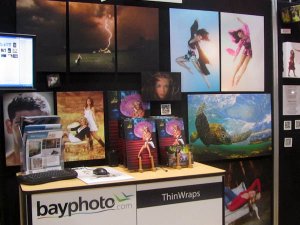 |
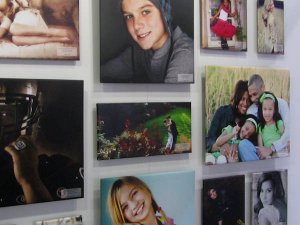 |
 |
| Shootsac makes camera accessory bags that don’t look like camera accessory bags. Designed with the female photographer in mind, they’re both practical and fashionable. | 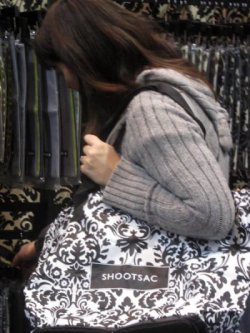 |
| Triple Scoop Music is in the business of licensing music. They have a large library of more than 7000 songs.
Photographers that want to use music for slideshows and/or videos can license any of these songs which can then be used royalty-free. Having licensed music in the past, I am convinced that having a single point of contact makes for a hassle-free way to add music to your productions. For more information contact Triple Scoop Music. |
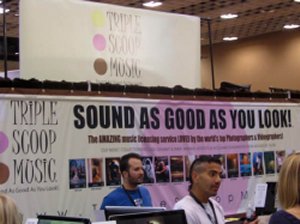 |
| Having heard about Fuji‘s 3D camera, I stopped by their booth for a demo.
The Fuji W3 camera is an advanced point-and-shoot with two lenses. When you snap a photo, the two images are combined to form a single “.mpo” file which you can immediately view on the specially designed 3-1/2″ LCD without using glasses. Plug your camera into a 3D television, pop on a set of glasses and you’ll see amazing 3D effect of this camera. Below is an example. When viewed, I was able to see the 3D effect of my outstretched hand. This stuff is cool. For more information see Fuji |
|
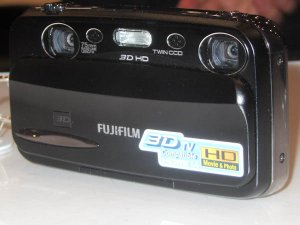 |
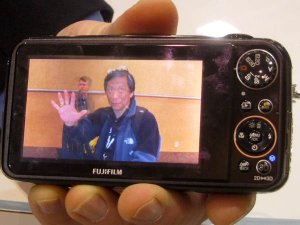 |
As a frequent trade show goer, I’m sometimes blasé about walking up and down aisles. But this week, I could sense real excitement from both exhibitors and attendees. I too came away excited about the WPPI show.
This trade show is mainly about small businesses – photographers seeking the know-how to profit from their skills. They want to stay ready for the opportunities that arise as the economy recovers. I’m heartened to share the energy.
As an aside, I am a frequent visitor to the Las Vegas trade shows – 2 to 4 a year for the past 30 years. From my un-scientific measure, it’s been 4 years since I’ve seen Las Vegas as busy as this week. With concurrent conventions taking place the hotels, casinos and restaurants were filled. I’m hoping that this is a sign that things are looking up for economic growth all over.
Written by Arnie Lee
Winter Care For Your Camera
27th November 2010
The cold weather of winter is now upon us here in the upper midwest, but that doesn’t mean there won’t be plenty of opportunities for wonderful photographs. What it does mean, however, is that you’ll need to take extra care of your camera when you’re out in the cold. This is true for both digital SLRs and point-and-shoots.
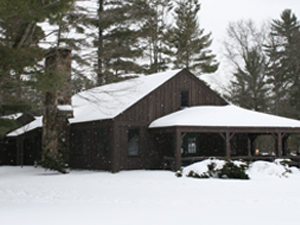 Snow scenes require special care for your camera |
You can help your camera stay warm as possible by keeping it under your coat. This will not only help it keep warm but will also protect it from the elements. The same is true for an external flash unit if you’re using one.
Another precaution against the cold is to bring spare batteries with you when you go outside. The batteries in your camera are likely to lose power faster at lower temperatures even if you’re not using the camera. Therefore, carry at least one extra set of batteries in your coat pocket where your body heat will keep them warm. Then, if your camera or flash batteries begin to fail, you can insert warm fresh batteries.
Condensation may be a problem you’ll have when you come inside from the winter cold. You’ve probably seen condensation on a glass of icy lemonade on a hot summer day. Your camera, especially the lens, is affected the same way when you bring it inside from the cold. The moisture from the warm air inside condenses on the cold surfaces of not only the lens, which can become completely covered, but also on the camera.
You can prevent condensation by wrapping the camera in a plastic bag or newspaper until it slowly reaches room temperature. The moisture will settle on the outside of the newspaper or bag and not on the camera. An even better idea is to place the bag on the camera while you’re still outside before you bring the camera inside.
Don’t use the camera if you notice that condensation has occurred. Instead, remove batteries and memory card and leave the compartments open until everything dries out. Don’t use the camera or take it back out in the cold until the condensation has disappeared.
So by dressing appropriately and properly caring for your camera, you’ll be taking great photographs in the cold of winter.
 Dress appropriately and enjoy the fun of winter photography |
Written by Scott Slaughter
« Older Posts